Monstera: varieties and their characteristics, planting and care features

Monstera delights with its appearance, excites the imagination with the myths that are associated with it, captivates with the ease of care and surprises with the fact that it has edible fruits. No wonder this sprawling ornamental plant adorns many houses of our compatriots.
Origin
Monstera is a plant of the Aroid family, famous primarily for its large leaves. The name of the plant translates as "bizarre" (another version of "monster"), and the rainforests of Central America are called homeland. In nature, liana is also found in Asia, South America, in the tropics of Mexico, Costa Rica, Panama. In Australia, it is grown for the edible ears.
In temperate climates, monstera is commonly cultivated as an indoor ornamental plant.


Many conflicting statements are associated with it, one of which concerns poisonousness. This issue will be covered in more detail in a separate chapter of this article. Now let's dwell on other features of growing vines at home. It has large leaves, and therefore actively releases oxygen and evaporates moisture. All this allows you to maintain an optimal indoor climate. The huge leaves of the vine absorb electromagnetic radiation, vaporization of formaldehyde.
Often the monster can be seen in offices, lecture halls, libraries. And this is due not only to the fact that a large plant looks attractive in large rooms, but also to the fact that it has a positive effect on the nervous system - it calms, allows you to focus, harmonizes thoughts. In addition, liana has strengthening properties.
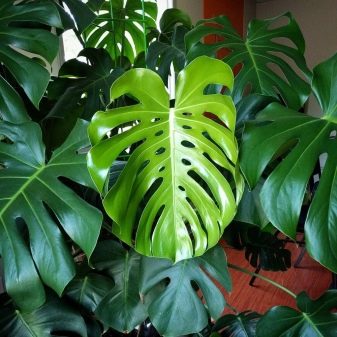
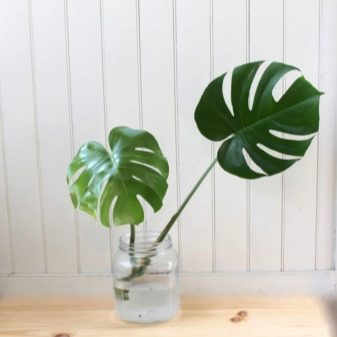
Description
Monstera grows in a peculiar way. At first, the stem is overgrown with leaves, they are formed several times a year. In most cases, the leaves of young vines do not have the usual holes. They gradually increase, and then their appearance stops. The plant "acquires" aerial roots. This stage is again replaced by a period of the appearance of new plates and an increase in their size. Then the growth of leaves stops again, the plant directs its forces to build up aerial roots.
In older vines, side shoots are also formed along with leaves.

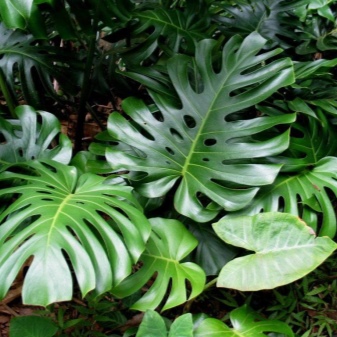
Leaves
Liana is known for its huge plate plates. As a rule, the diameter of the leaf reaches 70-90 cm. In the tropics, this figure can exceed 1 m. When growing at home, the liana usually has a slightly smaller plate size - on average 50-70 cm. The leaves are attached to the trunk with long petioles that wrap around the stem. The plates are covered with a shiny leather skin, have a green color (from light to deep dark). As already mentioned, the leaves of a young creeper are slightly smaller and do not yet have perforations. They are characterized by a lighter color. As the plant grows, the leaves darken, increase in size, and cuts or perforations appear over their entire surface.
Leaves with "holes" appear first as a rolled tube, which then opens, turning into a plate with characteristic openwork "holes". After that, the sheet increases a little more in size, becomes denser and acquires a beautiful shine. The older the monstera leaf, the more pronounced its segmentation becomes. Over time, the leaves become pinnately dissected.The plant acquires an easily recognizable original "appearance".
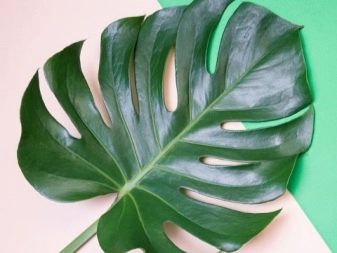
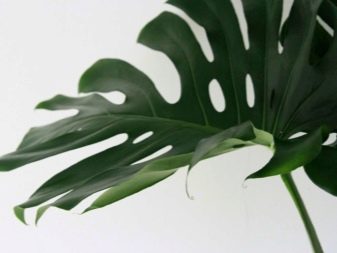
Flowers
Liana blooms with small flowers collected in inflorescences. They form a cylinder-shaped inflorescence reaching a height of 20-25 cm. Outwardly, this inflorescence resembles an ear of corn. Around the latter, a delicate floral blanket of white, cream or yellowish color is formed. As the ear ripens, the "cover" dries up and falls off.
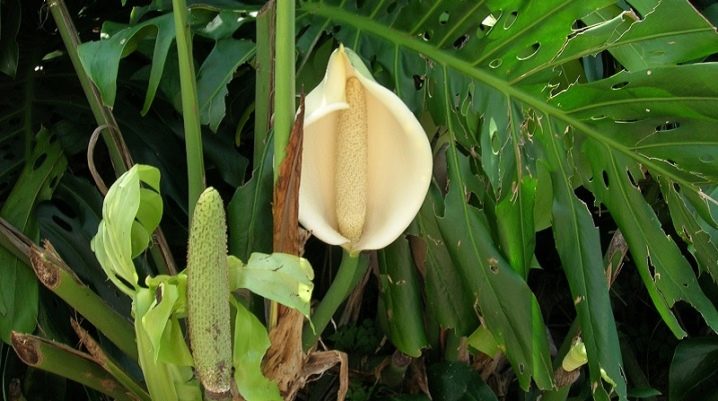
Fruit
The fruit of a liana is an ear formed by small, small fruit clusters pressed against each other. They taste like pineapple combined with strawberries. The cob is formed 10-12 months after flowering. The purple color of the cob indicates maturity.
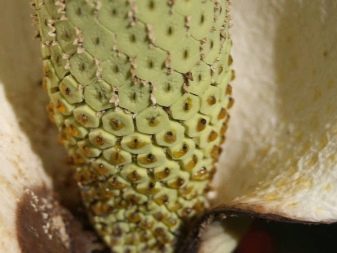
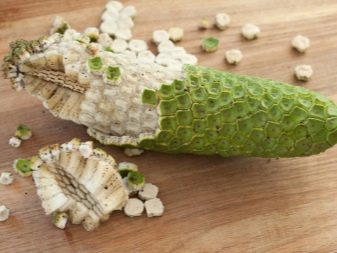
Roots
In addition to the usual underground roots, monstera also has airy ones. They act as a source of moisture, and also help vines to cling to tree trunks, striving upward. That is why, in natural conditions, the vine looks powerful.
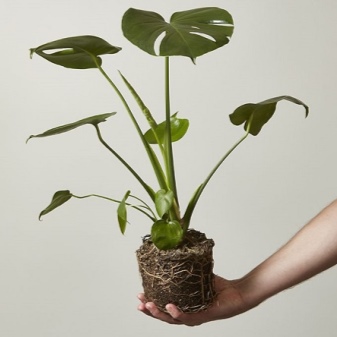
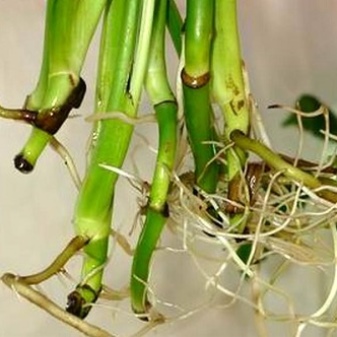
Poisonous or not?
For a long time, Europeans considered the monster a killer plant. One of the reasons for this is the bodies of dead people found in the tropics, entwined and pierced by a liana. However, their death occurred for other reasons, and the shoots of the monstera in the wild are so strong that they germinate through any obstacles. Thus, the myth of the cruelty and bloodthirstiness of the monstera was dispelled.
Another is related to the possible venomousness of the monstera. Indeed, the intercellular spaces of liana leaves contain thin needle-like formations of calcium oxalate. They are called rafids. In contact with mucous membranes and skin, they can cause burning, redness. If rafids in a certain amount enter the human body, poisoning is possible. The characteristic symptoms of the latter will be numbness of the pharynx, difficulty breathing, loss of voice. However, this is possible if you chew the leaves and cuttings of the monstera. The plant itself is not dangerous - it does not release toxins into the air. However, it is better to refuse to grow it in the house if the family has small children and pets.

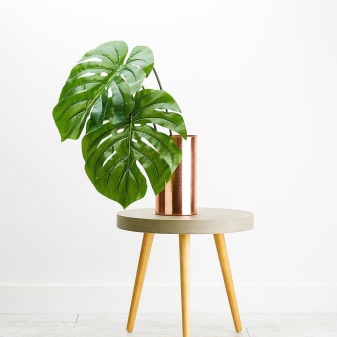
Varieties
Monstera has about 50 species. Let's consider the most popular ones.
Monstera Adonson
Liana up to 8 m high. The leaves are 20-25 cm long and 15-40 cm wide. Their shape is ovoid, they are evenly covered with holes. During flowering, an ear is formed, wrapped in a milky-yellow floral “cover”.
It is fair to say that it rarely blooms when grown at home.

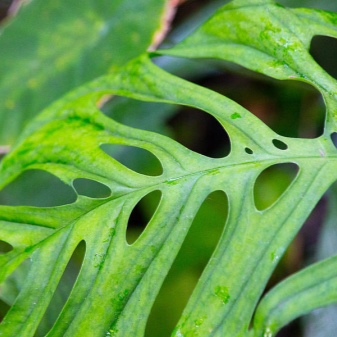
Monstera Borziga
Liana is originally from Mexico. Has heart-shaped plates with incisions along the edges. The color of the leaves is deep dark green. The plates are medium-sized - about 30 cm in diameter, have a long thin stalk.
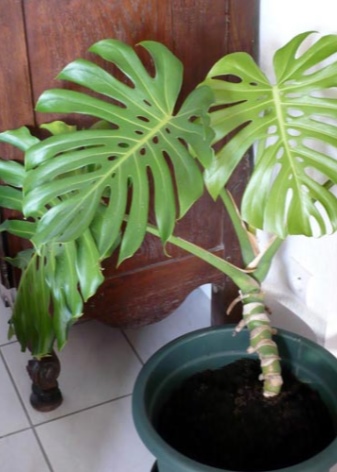

Punched or leaky monstera
Liana, characterized by large leaves up to 1 m in length. They are completely covered with "holes" of various shapes and sizes. When inflorescence forms an ear up to 10 cm high, surrounded by a lush white blanket.
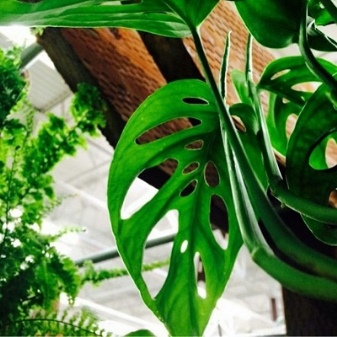
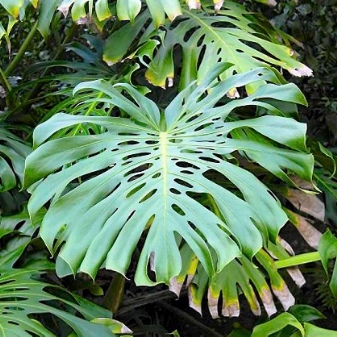
Monstera gourmet
It has heart-shaped plates, pinnately dissected, bright green color. The liana reaches a height of 3 m when grown indoors and 10-12 m when cultivated in a greenhouse. This vine got its name due to its ability to bear fruit. After flowering, a soft berry is formed with a pineapple flavor. At home, the fruit ripens in an average of 10 months. It is interesting that this particular variety can be seen more often than others in apartments and offices. However, few people manage to harvest from it.
Another name is the perforated philodendron.
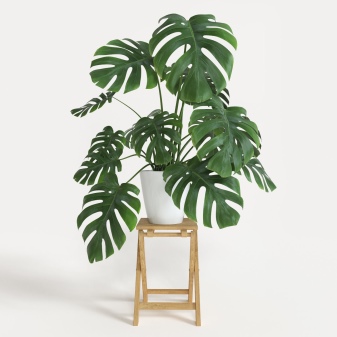
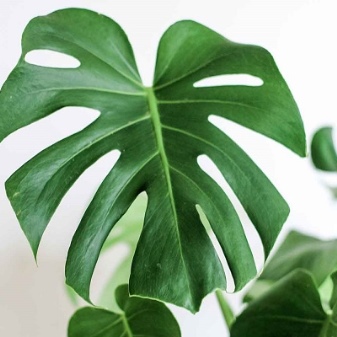
Oblique, uneven (sickle) monstera
The climbing liana is native to the humid tropics of Brazil. The name indicates the peculiarity of the leaf plates - one half of the leaf is slightly larger than the other in size. They are attached to the "trunk" by means of a short stem. They have a light green color and are covered with large oblong holes, the edges are solid. When flowering, forms a small (4-6 cm tall) cob.

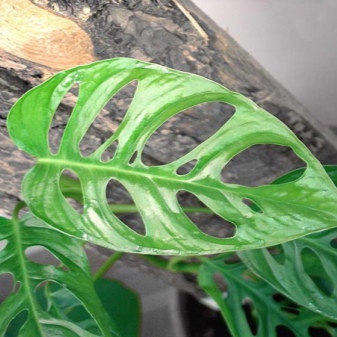
Monstera Karvinsky
It reaches a height of 3 m.Young vines have whole leaves, as the plant matures, the leaves are dissected, perforations are formed on them.
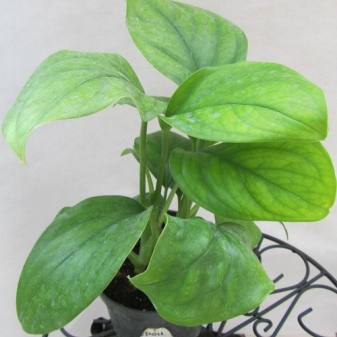
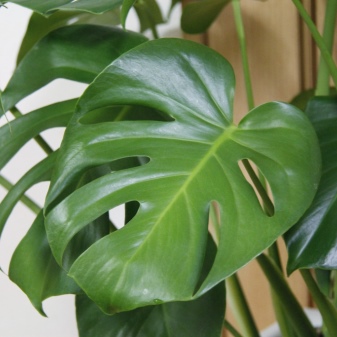
Sharpened Monstera
It got its name because of the shape of the leaves - they are pointed at the ends. The leaf plates are dark green, solid. Holes and cuts appear as the plant grows. Variegated (verily variety) monsters are especially fond of florists. They look especially original in the interior. These include the already mentioned Borziga, as well as Alba (characterized by slower growth rates, but also by a more capricious character), marble monstera (has a green-yellow leaf color).
Another rare variety of variegated monstera is dubious or dubia. The young plant has solid green plates with a silvery edging along the edges. As the plant matures, the leaves turn green and become perforated. A feature of the dubious monstera is its small size, it can be grown without props like an ampelous vine. A miniature thin monster can also be attributed to ampelous. The young plant has tender, heart-shaped leaves. In an older plant, they are pinnately dissected.
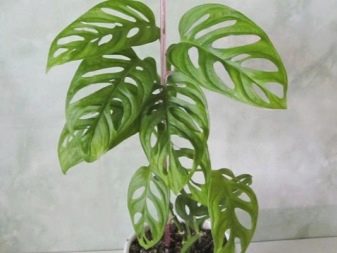
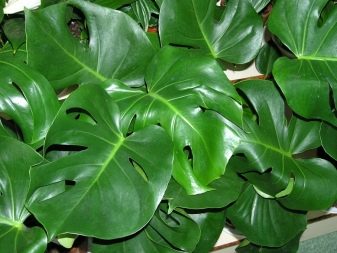
Features of reproduction and flowering
Reproduction of monstera is possible by seed and vegetative method. A light soil mixture is required to germinate the seeds. It must pass air and moisture well. Seeds need to be planted shallowly into the soil, leaving a distance of 4-5 cm between each seed. After that, carefully moisten the soil and cover the seeds with foil or glass. During the month, it is important to maintain the room temperature at least 24-25 C. During the day, the glass (film) should be lifted several times, leaving the seedlings in the open air for 3-15 minutes (the time should be increased gradually). Moisten the soil as necessary.
In about a month, greens will appear, after which each sprout should be transplanted into a separate container. Monster seeds are propagated less frequently than vegetatively. The latter involves cutting off the apical or stem cuttings from an adult plant. Vegetative propagation is carried out in the spring.
An important point - the cutting should have at least one bud and a mature leaf. It is better to take a shoot that has already acquired aerial roots.
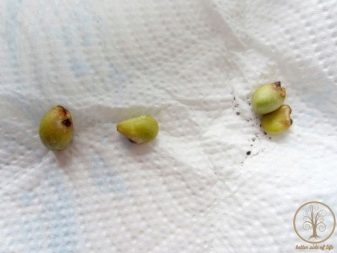
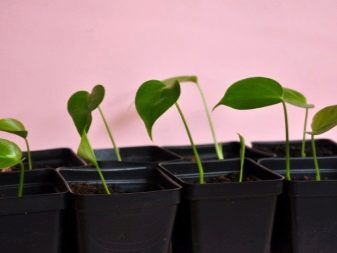
The upper cut (straight) is made over the kidney. The stalk is placed in the soil, leaving half of the knot in the air. Cover the top with a glass jar. The soil is moistened through the pallet. After 3-5 weeks, young shoots should form, after which you can remove the jar and transplant the young plant. Finally, reproduction of the monstera can be done by dividing the root and rooting the side shoots. When lateral shoots appear at the bottom of the roots, they need to be rooted. In this case, breeding is also best planned in early spring. The rooted shoot will soon acquire the first leaf and aerial roots. It is now ready to be transplanted into a separate container.
An adult creeper root can be divided into parts during transplantation. The selected "piece" should have a part of the underground root and a full rosette of leaves (or at least a growing point). The divided roots are immediately planted in different containers. Despite the fact that monstera is a deciduous ornamental plant, with proper care, it blooms even at home. Naturally, for a set of color, the conditions for caring for a vine should be as close as possible to those that surround a vine in the wild. In the tropics (sometimes greenhouses), the liana blooms annually, at home - once every 2-3 years.
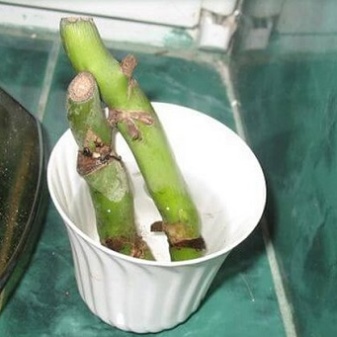
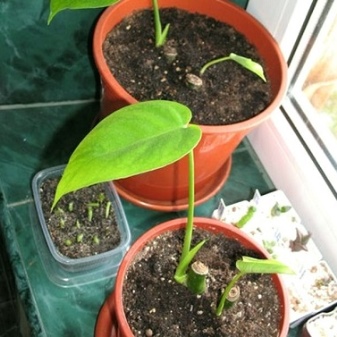
Landing rules
For growing monstera, you can take a ready-made substrate - universal or soil for palm trees. If you decide to cook it yourself, take turf, humus, sand and peat in equal proportions. Do not forget about the drainage layer, which will take up the third part of the pot.If you notice that an adult liana has stretched out, and its lower leaves have begun to fall off, it needs rejuvenation, that is, a transplant. To do this, in early spring, the top of the plant should be cut off. At the bottom, leave a "stump" with a height of 30-35 cm. Soon from this "stump" you will see young shoots. The cut off top can be placed in a container of water and wait for it to take root. It is desirable that the rhizomes fill the entire container. After that, you can plant the top in the ground.
Young plants (no rejuvenation) should be replanted annually. When the plants reach 4 years of age, it can be transplanted every 2-3 years. It is enough to replant adult plants every 4-5 years. If an adult plant feels good for several years in the same pot (does not waddle, does not wither), then you can not transplant it. In this case, it is recommended to replace the upper part of the soil with a new layer of earth only once a year. The root system of the vine becomes more and more powerful every year, so with each subsequent transplant, choose an ever larger pot. It should be wide, deep and firm.
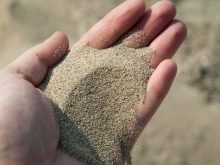

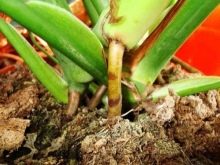
The nuances of care
In general, it is not difficult to care for a vine, it is considered an unpretentious plant. It can withstand air pollution, temperature drops, short-term droughts. It is better to decide once and for all on the place for the vines in the room - the plant does not like when it is moved. An important nuance, photosynthesis is actively taking place at night, so it is better not to put the plant in the bedroom.
It should be understood that the monstera grows to a large size, so there is clearly not enough space on the windowsill for it. The average lifespan of an evergreen monstera is 10 years. If you put a monster in front of the window, after a year and a half, be prepared for the fact that the room will be twilight, and you will no longer see what is happening outside the window. The liana will grow and unfold its leaves so much.
The location of the creeper against the wall half a meter from the window will help to avoid this. You can put the pot on a table or stand; on the wall behind the plant, it is ideal to organize fluorescent lighting. It will be needed in the autumn-winter period, when the plant lacks light.
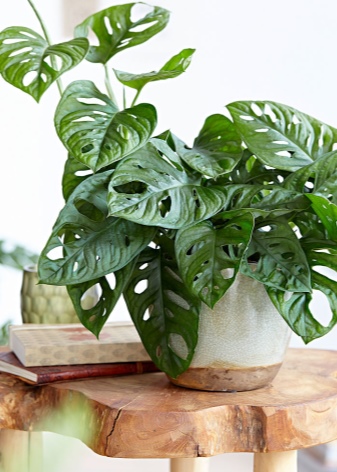

When choosing a place for a tub with a green exotic, avoid direct sunlight. They cause leaf burns. However, darkened areas will also be unsuitable. The plant will begin to wither and wither. Liana loves bright, but diffused light. On especially hot and sunny days, you can shade it slightly.
Varieties with variegated and contrasting colors are more demanding on lighting conditions. The light should be bright, but always diffused. If you break this rule, the leaves will lose their "zest" - white stripes, strokes and spots and become just dark green. If you observe this with your pet, the likely reason is a lack of light.
The optimal temperature regime for liana is from 16 to 24 C. Despite the fact that it tolerates "jumps" in temperatures well, it is better to minimize the latter. With a strong decrease in temperature, the growth rate slows down, the monster does not have enough strength to gain inflorescences. In winter, it is recommended to lower the temperature to 14-16 C. It is important to avoid drafts.
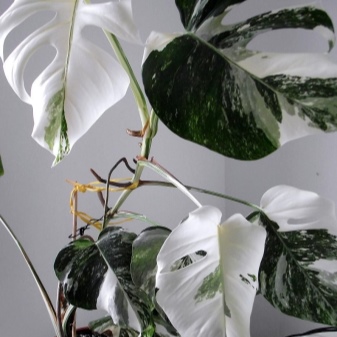

Watering is required in moderation, it is important not to allow the land to dry out. In spring and summer, watering is more intensive. In winter, you can water the plant on the second or third day after the earthen lump has become dry. In summer, the leaves should be irrigated with water every 2-4 days. In winter, you do not need to spray the leaves; it is better to put a container of water next to the plant or periodically wipe the leaves with a damp soft cloth.
Starting from March, every 14-18 days, you need to fertilize the plants using complex mineral fertilizers for decorative deciduous plants. There are special feeds for ficus and monstera. Adult vines can be fed with organic fertilizers every 3 months.For this, humus is suitable (pour a thin layer on the surface) or watering with an infusion of a fermented cowshed. The latter is diluted with water in a ratio of 1: 20. Fertilizers are stopped by the end of August.
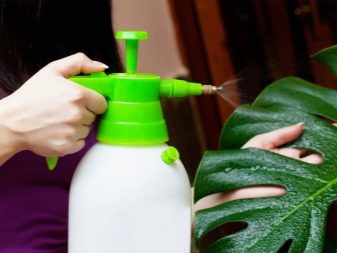
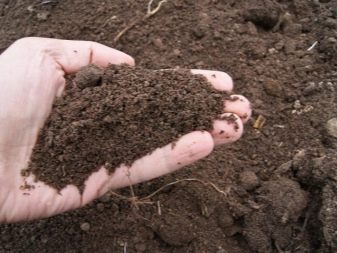
A lack of nutrition is evidenced by a slowdown in growth rates, the inability of the plant to grow large leaves, whole leaves (no perforation), a decrease in the intensity of leaf color, frail and thin aerial roots. The plant has aerial roots, which are essential for nutrition and hydration. You cannot trim them, but if you find the appearance of the vines unattractive because of the roots, then tie them around the trunk and wrap them with moss. During watering, the moss will also need to be moistened so that the plant “feeds” through the masked aerial roots.
Improper care is evidenced by a change in the appearance of the monstera. Dry leaves indicate a lack of moisture, excessive exposure to the sun. Yellow leaves combined with decaying roots are a sign of waterlogged soil. Only an emergency transplant and adherence to the watering regime will help to save the plant.
With a lack of light, the leaves begin to actively fall off, exposing the trunk of the monstera. Growth rates slow down, flowering is absent. If a brown border appears at the edges of the leaves, the plant asks for a transplant into a larger pot.
Another reason is too dry indoor air (this happens in winter if the plant stands near batteries, heaters).
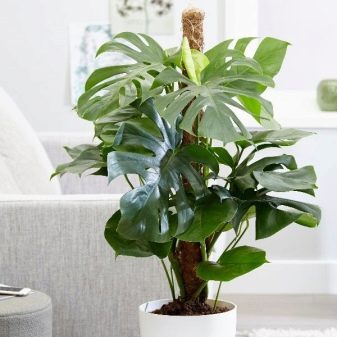

If the leaves remain intact, that is, no curly holes appear on them, then the monstera does not have enough nutrients. Review your fertilization schedule. A growing vine needs support. For support, it is better to purchase a special trunk with a height of 70-100 cm. Otherwise, the monstera may break under its own weight.
The aerial roots at the bottom of the trunk also serve as a support for the plant. They gradually sink into the ground. It is not worth cutting off or otherwise getting rid of them; it is recommended to bend them down and direct them to the ground. But the top of an adult plant is allowed to be cut periodically, this stimulates the growth of new shoots.
Often, drops collect on the leaves of the monstera, which flow down. Usually they say that the monstera is crying. There are two reasons for this. The first is associated with excessive watering of the plant. In addition, such "behavior" of vines is sometimes noted before cloudy weather or the beginning of rains.
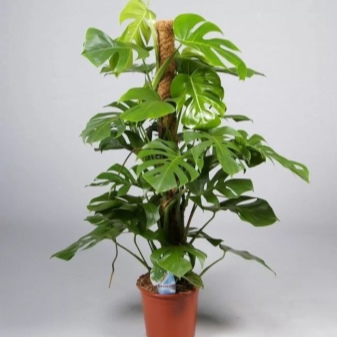
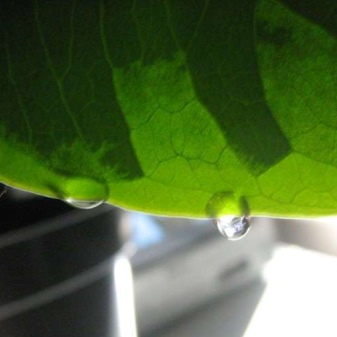
Pests and diseases
One of the most common diseases of monstera is rot. It is caused by excessive watering of the plant. The soil in the pot becomes wet, the root system begins to rot. Gradually, the rot rises higher and higher, covering the trunk and leaves. Liana turns black and withers. Root decay often occurs if the plant "sits" in a pot that is too large. The soil in it does not have time to dry out and begins to sour. As a rule, this happens in the autumn-winter time, when the temperature of the environment decreases.
Treatment consists of an emergency liana transplant, cutting off decaying roots and treating fresh soil with a fungicide. Treat the places of cuts of rotten areas with a solution of potassium permanganate or sprinkle with crushed charcoal. Old drainage cannot be used. The pot can, of course, be thoroughly rinsed and disinfected as well. When transplanting, follow the same planting rules: 1/3 of the pot is filled with drainage (small stones), filled with soil mixture. After planting, the monster needs to be watered with phytosporin, and sprayed with the leaf plates. Pests can also cause changes in the appearance and death of a plant. Among the most common are the following.

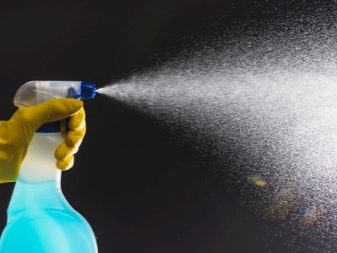
Spider mite
On the surface of the plates, usually from the inside, small cobwebs are clearly visible. The leaves themselves become soft, the plant slows down in growth. The reason for the appearance is excessive dryness of the air. Spraying vine leaves and air in the room will help prevent this.
Mechanical removal of the mites (if possible, it is better to rinse the plant under water), as well as the use of "Fitoverma", "Aktellika", "Akarina" will help to fight against ticks. It is important to follow the instructions and carry out the treatment as many times as required by the insecticide manufacturer.
You should not stop after the first treatment, even if it seems that the ticks have left the vine.
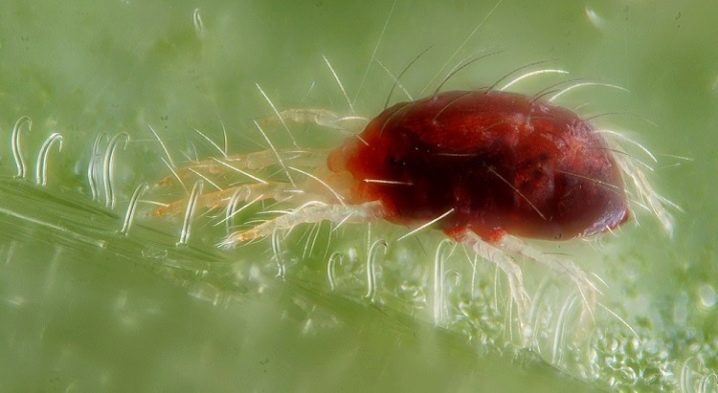
Shield
Symptoms of the lesion are wilting and falling leaves. Brown spots are distinguishable on their surface, these are pests.
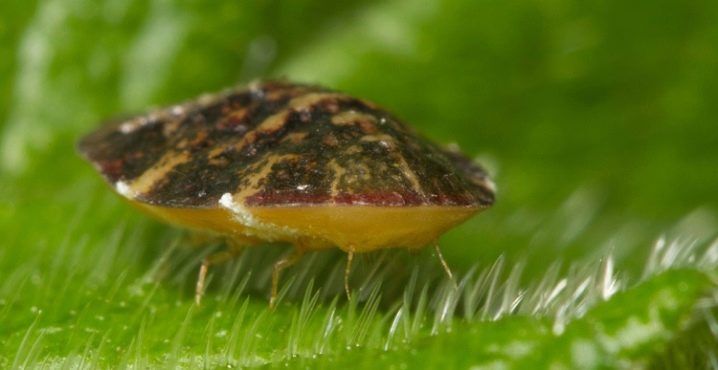
Mealybug
The curvature of shoots and leaves speaks of the defeat of the monstera by this pest, over time they dry out and fall off. Young leaves and shoots are also covered with a white powdery coating. A small amount of worms can be washed off by bathing the monster in the shower or by wiping each leaf with soapy water. In case of a large accumulation of pests, it is better to resort to insecticide treatment (for example, Fitoverm).

Thrips
If the monster is hit by thrips, then white specks appear on the outside of the leaf. On the inside of the plate, you can also see the pests themselves. Their appearance is usually caused by dry air and high ambient temperatures. For the fight, it is better to choose one of the above insecticides, and as a preventive measure, reduce the temperature regime, regularly humidify the air. To get rid of parasites, you should collect them mechanically, and then treat the monster with an appropriate insecticide.
When a monstera is affected by the thyroid gland, it also begins to fade, losing its spreading leaves. Pests secrete a sticky coating on which a sooty (black) fungus begins to form. At the first symptoms of infection, the pest can be removed from the leaves with a cotton swab, which is moistened with soapy water or alcohol. If it is impossible to cope with the parasite in this way, use insecticides (for example, Biotlin, Aktara).
In general, experienced flower growers note that, subject to the rules of care, the monstera is practically not susceptible to diseases and pest attacks.
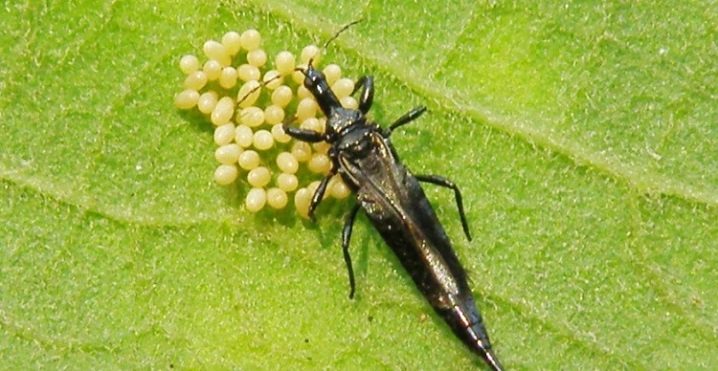
For information on how to transplant a monster at home, see the next video.




























The comment was sent successfully.